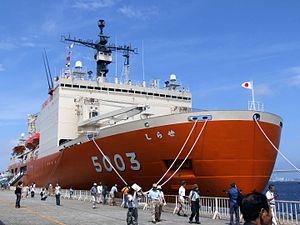Japanese icebreaker Shirase (AGB-5003)
 From Wikipedia the free encyclopedia
From Wikipedia the free encyclopedia
 | |
| History | |
|---|---|
| Name |
|
| Namesake | Shirase Glacier |
| Laid down | 15 March 2007 |
| Launched | 16 April 2008 |
| Commissioned | 20 May 2009 |
| Homeport | Yokosuka |
| Identification |
|
| Status | Active |
| Class overview | |
| Preceded by | Shirase class (1981) |
| Succeeded by | N/A |
| General characteristics [1] | |
| Type | Icebreaker |
| Displacement | Approx. 20,000 tons |
| Length | 138 m (452 ft 9 in) |
| Beam | 28 m (91 ft 10 in) |
| Draft | 9.2 m (30 ft 2 in) |
| Propulsion |
|
| Speed |
|
| Capacity |
|
| Complement | 175 |
| Aircraft carried | 3 helicopters |
Shirase (しらせ) is a Japanese icebreaker operated by the Japan Maritime Self-Defense Force and is Japan's fourth icebreaker for Antarctic expeditions. She inherited her name from her predecessor.
She was launched in April 2008 and commissioned in May 2009 with the hull number AGB-5003. She began her first voyage on 10 November 2009.
Name[edit]
In Japanese, the name "Shirase" is written in hiragana.[2] Due to a JMSDF internal naming rule, an icebreaker must be named after a place.[3] Accordingly, Shirase was named after the Shirase Glacier.[2] This glacier bears the family name of Lieutenant Nobu Shirase, a Japanese pioneer in Antarctic exploration.[4]
Operations[edit]
In February 2013, the anti-whaling group Sea Shepherd Conservation Society claimed the Shirase was sent to monitor its interference with the Japanese cetacean research fleet.[5] However, according to the National Institute of Polar Research, the icebreaker was in fact far to the west off the coast of Antarctica near the Showa Base, at the time.[6] The Japanese government subsequently confirmed that the vessel was not involved in any operation related to the whaling program,[7] and that Sea Shepherd's claims were "completely fake".[8]
On 17 February 2014, the Shirase ran aground just off the unmanned Molodyozhnaya Station in Antarctica. While the outer hull was penetrated, the vessel was in no danger of sinking and no fuel oil leakage was reported.[9]
On August 17, 2017, a CH-101 helicopter of the Japan Maritime Self-Defense Force assigned to the Shirase crashed at Iwakuni Air Base in Yamaguchi Prefecture. Four crewmembers were injured.[10][11][12]
References[edit]
- ^ Yamauchi, Y.; Shigeya, M. (2011). "The Icebreaking Performance of Shirase in the Maiden Antarctic Voyage" (PDF). Proceedings of the Twenty-First (2011) International Offshore and Polar Engineering Conference. Archived from the original (PDF) on February 24, 2014.
- ^ a b 砕氷艦「しらせ」除籍記念特集サイト [Special site memorializing retired icebreaker "Shirase"] (in Japanese). Japan Maritime Self-Defense Force. Retrieved 10 February 2010.[permanent dead link]
- ^ 世界有数の砕氷船「しらせ」 [The world's foremost icebreaker "Shirase"] (in Japanese). National Institute of Polar Research. p. 1. Retrieved 10 February 2010.[permanent dead link]
- ^ 遠藤知子 (November 2003). 南極観測船しらせ(晴海埠頭) [Antarctic observation ship Shirase (Harumi Pier)] (in Japanese). Akita Prefecture. Archived from the original on 12 February 2007. Retrieved 10 February 2010.
- ^ Darby, Andrew (25 February 2013). "Military icebreaker arrives to defend Japanese whalers". The Age. Retrieved 25 February 2013.
- ^ "Shirase". National Institute of Polar Research. Archived from the original on 1 December 2017. Retrieved 9 May 2015.
- ^ "Japan's friendship". The Australian. 2 March 2013. Retrieved 9 May 2015.
- ^ [1] Archived March 28, 2013, at the Wayback Machine
- ^ Shirase runs aground off Antarctica Archived 2014-02-19 at archive.today. NHK World, 17 February 2014. Retrieved 2014-02-19.
- ^ Four Japanese servicemen injured after GSDF helicopter flips in Iwakuni August 18, 2017 Japan Times Retrieved September 2, 2017
- ^ Masumoto, Hana Four injured after Japanese military helicopter flips over at Iwakuni August 18, 2017 Stars and Stripes Retrieved September 2, 2017
- ^ Rahmat, Ridzwan (August 18, 2017). "Japanese navy helicopter crashes during VERTREP training, injures three". Jane's. Archived from the original on October 13, 2017. Retrieved October 13, 2017.